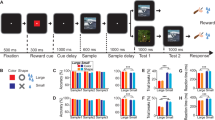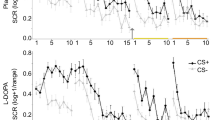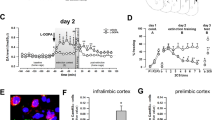Abstract
Dopamine is critical for many processes that drive learning and memory, including motivation, prediction error, incentive salience, memory consolidation, and response output. Theories of dopamine’s function in these processes have, for the most part, been developed from behavioral approaches that examine learning mechanisms in appetitive tasks. A parallel and growing literature indicates that dopamine signaling is involved in consolidation of memories into stable representations in aversive tasks such as fear conditioning. Relatively little is known about how dopamine may modulate memories that form during extinction, when organisms learn that the relation between previously associated events is severed. We investigated whether fear and reward extinction share common mechanisms that could be enhanced with dopamine D1/5 receptor activation. Pharmacological activation of dopamine D1/5 receptors (with SKF 81297) enhanced extinction of both cued and contextual fear. These effects also occurred in the extinction of cocaine-induced conditioned place preference, suggesting that the observed effects on extinction were not specific to a particular type of procedure (aversive or appetitive). A cAMP/PKA biased D1 agonist (SKF 83959) did not affect fear extinction, whereas a broadly efficacious D1 agonist (SKF 83822) promoted fear extinction. Together, these findings show that dopamine D1/5 receptor activation is a target for the enhancement of fear or reward extinction.
Similar content being viewed by others
Log in or create a free account to read this content
Gain free access to this article, as well as selected content from this journal and more on nature.com
or
References
Abraham AD, Cunningham CL, Lattal KM (2012). Methylphenidate enhances extinction of contextual fear. Learn Mem 19: 67–72.
Abraham AD, Neve KA, Lattal KM (2014). Dopamine and extinction: a convergence of theory with fear and reward circuitry. Neurobiol Learn Mem 108: 65–77.
Andersen PH, Jansen JA (1990). Dopamine receptor agonists: selectivity and dopamine D1 receptor efficacy. Eur J Pharmacol 188: 335–347.
Andersson DR, Nissbrandt H, Bergquist F (2006). Partial depletion of dopamine in substantia nigra impairs motor performance without altering striatal dopamine neurotransmission. Eur J Neurosci 24: 617–624.
Arnsten AF, Dudley A (2005). Methylphenidate improves prefrontal cortical cognitive function through α-2 adrenoceptor and dopamine D1 receptor actions: relevance to therapeutic effects in Attention Deficit Hyperactivity Disorder. Behav Brain Funct 1: 2–11.
Beaulieu JM, Espinoza S, Gainetdinov RR (2015). Dopamine receptors—IUPHAR review 13. Br J Pharmacol 172: 1–23.
Bernardi RE, Lattal KM (2012). Prazosin differentially affects extinction of cocaine conditioned place preference on the basis of dose and initial preference. Neuroreport 23: 1048–1051.
Borowski TB, Kokkinidis L (1998). The effects of cocaine, amphetamine, and the dopamine D1 receptor agonist SKF 38393 on fear extinction as measured with potentiated startle: implications for psychomotor stimulant psychosis. Behav Neurosci 112: 952–965.
Bukalo O, Pinard CR, Holmes A (2014). Mechanisms to medicines: elucidating neural and molecular substrates of fear extinction to identify novel treatments for anxiety disorders. Br J Pharmacol 171: 4690–4718.
Carmack SA, Wood SC, Anagnostaras SG (2010). Amphetamine and extinction of cued fear. Neurosci Lett 468: 18–22.
Chausmer AL, Katz JL (2002). Comparison of interactions of D1-like agonists, SKF 81297, SKF 82958 and A-77636, with cocaine: locomotor activity and drug discrimination studies in rodents. Psychopharmacology (Berl) 159: 145–153.
Conroy JL, Free RB, Sibley DR (2015). Identification of G protein-biased agonists that fail to recruit β-arrestin or promote internalization of the D1 dopamine receptor. ACS Chem Neurosci 6: 681–692.
Cunningham CL, Gremel CM, Groblewski PA (2006). Drug-induced conditioned place preference and aversion in mice. Nat Protoc 1: 1662–1670.
Cunningham CL, Henderson CM, Bormann NM (1998). Extinction of ethanol-induced conditioned place preference and conditioned place aversion: effects of naloxone. Psychopharmacology (Berl) 139: 62–70.
Diaz Heijtz R, Castellanos FX (2006). Differential effects of a selective dopamine D1-like receptor agonist on motor activity and c-fos expression in the frontal-striatal circuitry of SHR and Wistar-Kyoto rats. Behav Brain Funct 2: 18.
Dickinson A, Balleine B (2002) The role of learning in the operation of motivational systems. In: Gallistel CR (ed). Steven’s Handbook of Experimental Psychology: Learning, Motivation and Emotion. 3rd edn, Vol. 3. John Wiley & Sons: New York, pp 497–534.
Dubrovina NI, Zinov'eva DV (2010). Effects of activation and blockade of dopamine receptors on the extinction of a passive avoidance reaction in mice with a depressive-like state. Neurosci Behav Physiol 40: 55–59.
Fadok JP, Dickerson TM, Palmiter RD (2009). Dopamine is necessary for cue-dependent fear conditioning. J Neurosci 29: 11089–11097.
Fiorenza NG, Rosa J, Izquierdo I, Myskiw JC (2012). Modulation of the extinction of two different fear-motivated tasks in three distinct brain areas. Behav Brain Res 232: 210–216.
Fricks-Gleason AN, Khalaj AJ, Marshall JF (2012). Dopamine D1 receptor antagonism impairs extinction of cocaine-cue memories. Behav Brain Res 226: 357–360.
Gremel CM, Cunningham CL (2007). Role of test activity in ethanol-induced disruption of place preference expression in mice. Psychopharmacology (Berl) 191: 195–202.
Groblewski PA, Lattal KM, Cunningham CL (2009). Effects of D-cycloserine on extinction and reconditioning of ethanol-seeking behavior in mice. Alcohol Clin Exp Res 33: 772–782.
Gruene TM, Roberts E, Thomas V, Ronzio A, Shansky RM (2015). Sex-specific neuroanatomical correlates of fear expression in prefrontal-amygdala circuits. Biol Psychiatry 78: 186–193.
Guarraci FA, Frohardt RJ, Kapp BS (1999). Amygdaloid D1 dopamine receptor involvement in Pavlovian fear conditioning. Brain Res 827: 28–40.
Haaker J, Gaburro S, Sah A, Gartmann N, Lonsdorf TB, Meier K et al (2013). Single dose of L-dopa makes extinction memories context-independent and prevents the return of fear. Proc Natl Acad Sci USA 110: 2428–2436.
Hikind N, Maroun M (2008). Microinfusion of the D1 receptor antagonist, SCH23390 into the IL but not the BLA impairs consolidation of extinction of auditory fear conditioning. Neurobiol Learn Mem 90: 217–222.
Hitchcock LN, Cunningham CL, Lattal KM (2014). Cue configuration effects in acquisition and extinction of a cocaine-induced place preference. Behav Neurosci 128: 217–227.
Holmes NM, Westbrook RF (2014). Appetitive context conditioning proactively, but transiently, interferes with expression of counterconditioned context fear. Learn Mem 21: 597–605.
Holtzman-Assif O, Laurent V, Westbrook RF (2010). Blockade of dopamine activity in the nucleus accumbens impairs learning extinction of conditioned fear. Learn Mem 17: 71–75.
Horvitz JC (2000). Mesolimbocortical and nigrostriatal dopamine responses to salient non-reward events. Neuroscience 96: 651–656.
Inoue T, Izumi T, Maki Y, Muraki I, Koyama T (2000). Effect of the dopamine D(1/5) antagonist SCH 23390 on the acquisition of conditioned fear. Pharmacol Biochem Behav 66: 573–578.
Iordanova MD (2009). Dopaminergic modulation of appetitive and aversive predictive learning. Rev Neurosci 20: 383–404.
Iordanova MD, Westbrook RF, Killcross AS (2006). Dopamine activity in the nucleus accumbens modulates blocking in fear conditioning. Eur J Neurosci 24: 3265–3270.
Lattal KM, Maughan DK (2012). A parametric analysis of factors affecting acquisition and extinction of contextual fear in C57BL/6 and DBA/2 mice. Behav Processes 90: 49–57.
Maren S, Holmes A (2016). Stress and fear extinction. Neuropsychopharmacology 41: 58–79.
Matsumoto M, Hikosaka O (2009). Two types of dopamine neuron distinctly convey positive and negative motivational signals. Nature 459: 837–841.
Menezes J, Alves N, Borges S, Roehrs R, de Carvalho Myskiw J, Furini CR et al (2015). Facilitation of fear extinction by novelty depends on dopamine acting on D1-subtype dopamine receptors in hippocampus. Proc Natl Acad Sci USA 112: 1652–1658.
Nasser HM, McNally GP (2012). Appetitive-aversive interactions in Pavlovian fear conditioning. Behav Neurosci 126: 404–422.
National Institutes of Health (1985). NIH Publication 86-23 Revised. In Guide for the care and use of laboratory animals. Public Health Service, National Institutes of Health.
Neve K (2009) The Dopamine Receptors, 2nd edn. Humana Press: New York, NY, USA.
Nishi A, Kuroiwa M, Shuto T (2011). Mechanisms for the modulation of dopamine D(1) receptor signaling in striatal neurons. Front Neuroanat 5: 43.
O'Sullivan GJ, Dunleavy M, Hakansson K, Clementi M, Kinsella A, Waddington JL (2008). Dopamine D1 vs D5 receptor-dependent induction of seizures in relation to DARPP-32, ERK1/2 and GluR1-AMPA signalling. Neuropharmacology 54: 1051–1061.
Pezze MA, Feldon J (2004). Mesolimbic dopaminergic pathways in fear conditioning. Prog Neurobiol 74: 301–320.
Raczka KA, Mechias ML, Gartmann N, Reif A, Deckert J, Pessiglione M et al (2011). Empirical support for an involvement of the mesostriatal dopamine system in human fear extinction. Transl Psychiatry 1: e12.
Redgrave P, Prescott TJ, Gurney K (1999). Is the short-latency dopamine response too short to signal reward error? Trends Neurosci 22: 146–151.
Rey CD, Lipps J, Shansky RM (2014). Dopamine D1 receptor activation rescues extinction impairments in low-estrogen female rats and induces cortical layer-specific activation changes in prefrontal-amygdala circuits. Neuropsychopharmacology 39: 1282–1289.
Rossato JI, Bevilaqua LR, Izquierdo I, Medina JH, Cammarota M. (2009). Dopamine controls persistence of long-term memory storage. Science 325: 1017–1020.
Salamone JD (1994). The involvement of nucleus accumbens dopamine in appetitive and aversive motivation. Behav Brain Res 61: 117–133.
Schultz W, Apicella P, Ljungberg T (1993). Responses of monkey dopamine neurons to reward and conditioned stimuli during successive steps of learning a delayed response task. J Neurosci 13: 900–913.
Schultz W, Dickinson A (2000). Neuronal coding of prediction errors. Annu Rev Neurosci 23: 473–500.
Wagner A (1981) SOP: a model of automatic memory processing in animal behavior. In: Spear NE, Miller RR (eds). Information Processing in Animals: Memory Mechanisms. Erlbaum: Hillsdale, NJ, USA, pp 5–47.
Weber M, Hart J, Richardson R (2007). Effects of D-cycloserine on extinction of learned fear to an olfactory cue. Neurobiol Learn Mem 87: 476–482.
Wietzikoski EC, Boschen SL, Miyoshi E, Bortolanza M, Dos Santos LM, Frank M et al (2012). Roles of D1-like dopamine receptors in the nucleus accumbens and dorsolateral striatum in conditioned avoidance responses. Psychopharmacology (Berl) 219: 159–169.
Wood SC, Anagnostaras SG (2009). Memory and psychostimulants: modulation of Pavlovian fear conditioning by amphetamine in C57BL/6 mice. Psychopharmacology (Berl) 202: 197–206.
Zweifel LS, Fadok JP, Argilli E, Garelick MG, Jones GL, Dickerson TM et al (2011). Activation of dopamine neurons is critical for aversive conditioning and prevention of generalized anxiety. Nat Neurosci 14: 620–626.
Acknowledgements
This work was supported by NIH grants DA007262 (ADA), DA018165 (KML), DA025922 (KML), US Department of the Army/DOD-TATRC W81XWH-12-2-0048 (KML), and Merit Review Award BX000810 from the US Department of Veterans Affairs, Veterans Health Administration, Office of Research and Development, Biomedical Laboratory Research and Development (KAN).
Author information
Authors and Affiliations
Corresponding author
Additional information
Supplementary Information accompanies the paper on the Neuropsychopharmacology website
Supplementary information
Rights and permissions
About this article
Cite this article
Abraham, A., Neve, K. & Lattal, K. Activation of D1/5 Dopamine Receptors: A Common Mechanism for Enhancing Extinction of Fear and Reward-Seeking Behaviors. Neuropsychopharmacol 41, 2072–2081 (2016). https://doi.org/10.1038/npp.2016.5
Received:
Revised:
Accepted:
Published:
Issue date:
DOI: https://doi.org/10.1038/npp.2016.5
This article is cited by
-
Fear extinction rescuing effects of dopamine and L-DOPA in the ventromedial prefrontal cortex
Translational Psychiatry (2024)
-
External globus pallidus input to the dorsal striatum regulates habitual seeking behavior in male mice
Nature Communications (2023)
-
Chlorpromazine, an Inverse Agonist of D1R-Like, Differentially Targets Voltage-Gated Calcium Channel (CaV) Subtypes in mPFC Neurons
Molecular Neurobiology (2023)
-
The prefrontal cortex, pathological anxiety, and anxiety disorders
Neuropsychopharmacology (2022)
-
l-DOPA and consolidation of fear extinction learning among women with posttraumatic stress disorder
Translational Psychiatry (2020)



